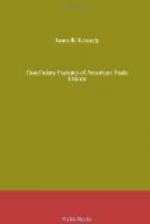1903 | 147,054.56| 3.42| 3,767.93| 3.77 | 179,355.00| 2.78| 11,680.00| 1.90
1904 | 163,226.18| 3.59| 2,945.68| 2.96 | 198,214.25| 2.59| 16,940.00| 2.18
1905 | 165,917.00| 3.73| 4,835.45| 4.95 | 174.946.28| | 14,345.00| 2.13
1906 | 162,905.82| 3.70| 2,945.68| 3.02 | 176,799.00| | |
------------------------------------------------------------
------------------
Differences in the rate of morbidity in different trades affect the cost, but these are relatively unimportant in the unions considered. A more important cause of difference in cost is the extent to which the unions are able to prevent the sick benefit from becoming a pension to members incapacitated by old age and disease. The heavy cost in the Typographia is partly due to the more liberal provision which is made for such members. In those unions, such as the Iron Molders and the Leather Workers on Horse Goods, which do not maintain an out-of-work benefit, the cost of the sick benefit is undoubtedly somewhat higher than it would be on account of the temptation of the unemployed member to feign illness.
CHAPTER IV.
OUT-OF-WORK BENEFITS.
The out-of-work benefit, of prime importance among English trade unions, has made little headway in America either as a national or even as a local trade-union benefit. In 1905 the amount expended for out-of-work benefits could not well have exceeded eighty thousand dollars, and of this sum a considerable part was spent by the Amalgamated Carpenters, a British trade union with branches in the United States. Certainly less than one half of one per cent. of the expenditures of American national unions, and less than one per cent. of their expenditures for beneficiary purposes, is for out-of-work relief. In the one hundred principal English trade unions twenty-one per cent. of the total expenditure in the ten years from 1892 to 1901 was for out-of-work benefits. Of the sum spent by the same unions for benefits of all kinds (not including strike pay) about one third was for out-of-work benefits.[155]
[Footnote 155: Weyl, “Benefit Features of British Trade Unions” in Bulletin of the Bureau of Labor, No. 64, p. 722.]
Relief to the unemployed member has assumed in American unions three forms: (a) an out-of-work benefit of a fixed amount per week in money, (b) exemption of unemployed members from weekly or monthly dues, and (c) a loan or benefit sufficient to transport the unemployed member in search of employment. The first and second of these are ordinarily known as out-of-work benefits, while the third is known as a travelling benefit.




